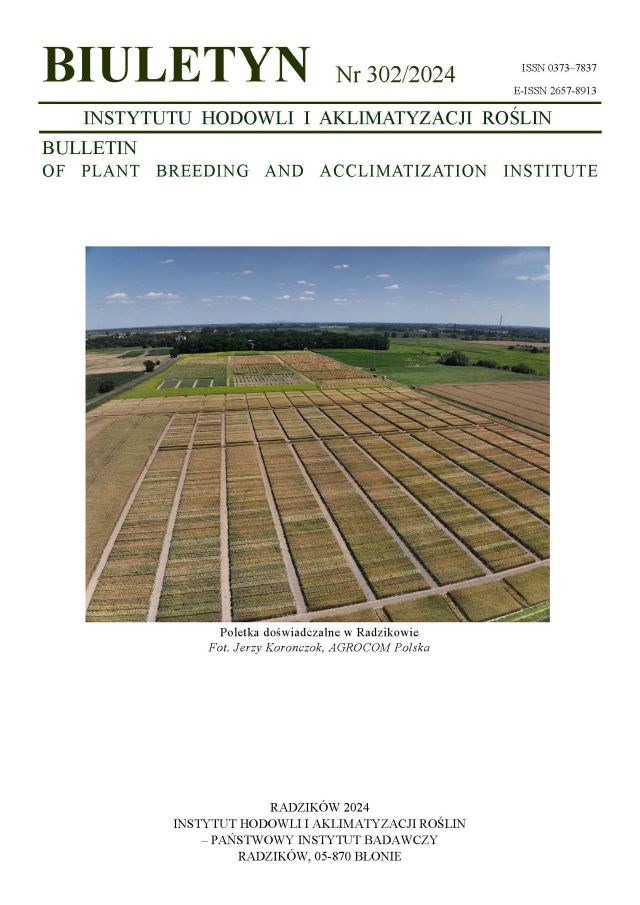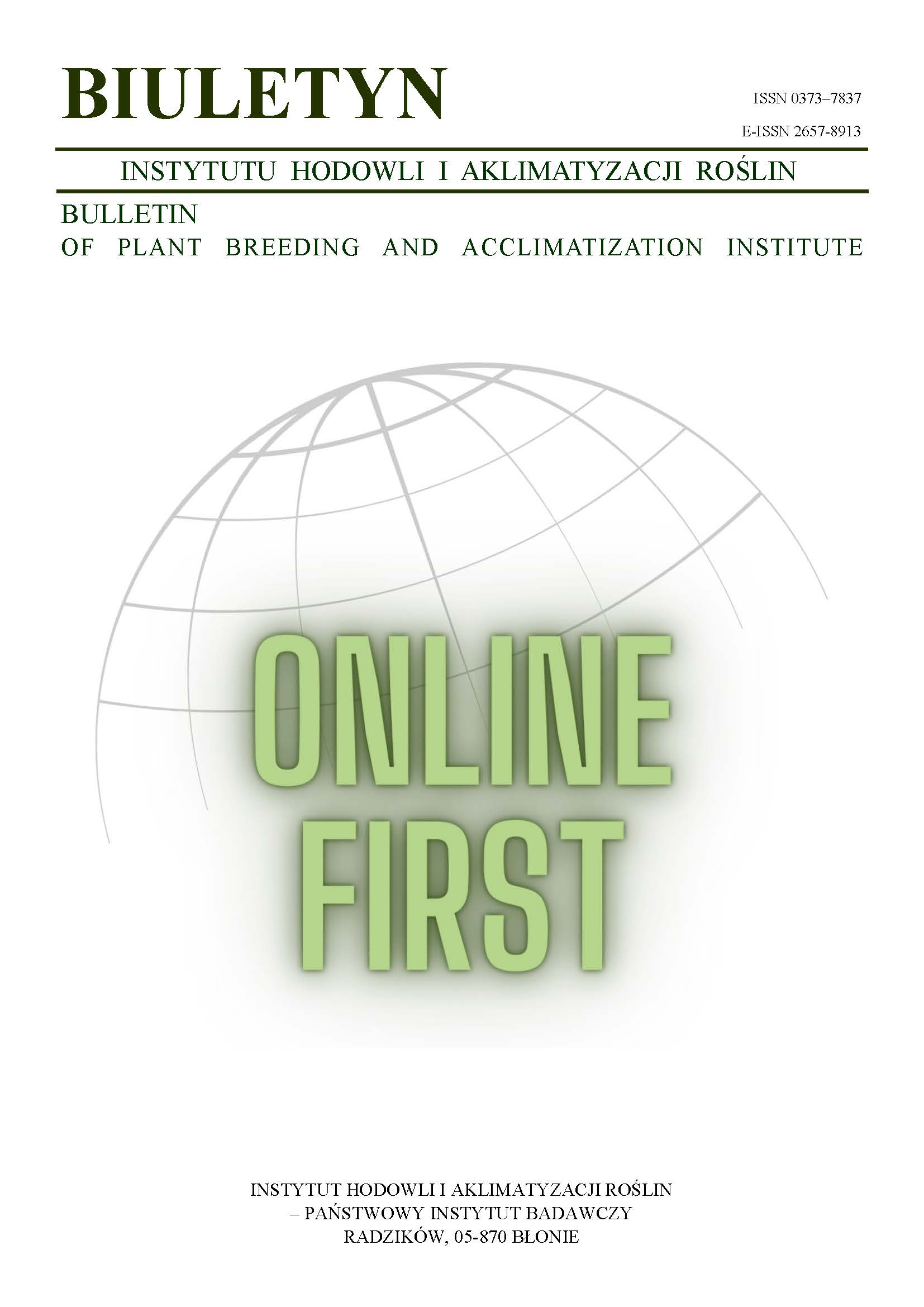The use of doubled haploids for detection of linkage of genes controlling some quantitative traits in barley
Tadeusz Adamski
office@igr.poznan.plInstytut Genetyki Roślin PAN, Poznań (Poland)
Zygmunt Kaczmarek
Instytut Genetyki Roślin PAN, Poznań (Poland)
Maria Surma
Instytut Genetyki Roślin PAN, Poznań (Poland)
Stanisław Czajka
Akademia Rolnicza im. A. Cieszkowskiego, Poznań (Poland)
Karolina Krystkowiak
Instytut Genetyki Roślin PAN, Poznań (Poland)
Anetta Kuczyńska
Instytut Genetyki Roślin PAN, Poznań (Poland)
Michał Rębarz
Instytut Genetyki Roślin PAN, Poznań (Poland)
Abstract
Barley doubled haploids (DH) were studied with the aim to detect linkage between genes conditioning pairs of metrical traits. Populations of DH lines derived from F1 and F2 hybrids from the cross Roland × Apex covered material for the study. The following traits were analysed: stem length, spike length, number of grains per spike, grain weight per spike and 1000-grain weight. On the basis of relations between means, variances and correlation coefficients in the F1DH and F2DH populations, the occurrence of linkage between genes responsible for stem length and genes conditioning spike length, grain number and grain weight per spike was recorded. Additionally, independent inheritance of stem length and 1000-grain weight was found.
Supporting Agencies
Keywords:
barley, doubled haploids, linkage, metrical traitsReferences
Barua U. M., Chalmers K. J., Thomas W. T. B., Hackett C. A., Lea V., Jack P., Forster B. P., Waugh R., Powell W. 1993. Molecular mapping of genes determining height, time to heading, and growth habit in barley (Hordeum vulgare L.). Genome 36: 1080 — 1087.
DOI: https://doi.org/10.1139/g93-143
Google Scholar
Czajka S., Kaczmarek Z., Adamski T., Surma M. 2002. LINKGEN — program obliczeniowy wykrywania sprzężeń genów i nieallelicznej interakcji. IGR PAN, Poznań, (nieopublikowany).
Google Scholar
Hayes P. M., Blake T., Chen T. H. H., Tragoonrung S., Chen F., Pan A., Liu B. 1993. Quantitative trait loci on barley (Hordeum vulgare L.) chromosome 7 associated with components of winterhardiness. Genome 36: 66 — 71.
DOI: https://doi.org/10.1139/g93-009
Google Scholar
Kaczmarek Z., Surma M., Adamski T. 1994. Theoretical bases for detection of linkage of genes between two quantitative characters in the presence of nonallelic interaction. Genet. Pol. 35: 53 — 62.
Google Scholar
Kasha K. J., Kao K. N. 1970. High frequency haploid production in barley (Hordeum vulgare L.). Nature 225: 874 — 876.
DOI: https://doi.org/10.1038/225874a0
Google Scholar
Kleinhofs A., Han F. 2002. Molecular mapping of the barley genome. In: Barley Science — Recent Advances from Molecular Biology to Agronomy of Yield and Quality (G. A. Slafer, J. L. Molina-Cano, R. Savin, J. L. Araus, I. Romagosa, eds.). Food Products Press, New York: 31 — 63.
DOI: https://doi.org/10.1201/9781003578536-3
Google Scholar
Pickering R. A., Devaux P. 1992. Haploid production: Approaches and use in plant breeding. W: Barley genetics, biochemistry, molecular biology and biotechnology (P. R. Shewry, ed.). CAB Inter. Wallingford, UK: 519 — 547.
Google Scholar
Snape J. W., Simpson E. 1981. The genetical expectations of doubled haploid lines derived from different filial generations. Theor. Appl. Genet. 60: 123 — 128.
DOI: https://doi.org/10.1007/BF00282430
Google Scholar
Surma M., Adamski T., Kaczmarek Z., Czajka S. 2003. Zmienność cech ilościowych linii DH i SSD jęczmienia. Biul. IHAR 226/227: 277 — 283.
Google Scholar
Thomas W. T. B., Powell W., Waugh R., Chalmers K. J., Barua U. M., Jack P., Lea V., Forster B. P., Swanston J. S., Ellis R. P., Hanson P. R., Lance R. C. 1995. Detection of quantitative trait loci for agronomic, yield, grain and disease characters in spring barley (Hordeum vulgare L.). Theor. Appl. Genet. 91: 1037 — 1047.
DOI: https://doi.org/10.1007/BF00223917
Google Scholar
Tinker N. A., Mather D. E., Rossnagel B. G., Kasha K. J., Kleinhofs A., Hayes P. M., Falk D. E., Ferguson T., Shugar L. P., Legge W. G., Irvine R. B., Choo T. M., Briggs M. A., Ullricg S. E., Franckowiak J. D., Blake T. K., Graf R. J., Dofing S. M., Saghai Maroof M. A., Scoles G. J., Hoffman D., Dahleen L. S., Kilian A., Chen F., Biyashev R. M., Kudrna D., Steffenson A. 1996. Regions of the genome that affect agronomic performance in two-row barley. Crop Sci. 36: 1053 — 1062.
DOI: https://doi.org/10.2135/cropsci1996.0011183X003600040040x
Google Scholar
Authors
Zygmunt KaczmarekInstytut Genetyki Roślin PAN, Poznań Poland
Authors
Maria SurmaInstytut Genetyki Roślin PAN, Poznań Poland
Authors
Stanisław CzajkaAkademia Rolnicza im. A. Cieszkowskiego, Poznań Poland
Authors
Karolina KrystkowiakInstytut Genetyki Roślin PAN, Poznań Poland
Authors
Anetta KuczyńskaInstytut Genetyki Roślin PAN, Poznań Poland
Authors
Michał RębarzInstytut Genetyki Roślin PAN, Poznań Poland
Statistics
Abstract views: 26PDF downloads: 7
License
Copyright (c) 2004 Tadeusz Adamski, Zygmunt Kaczmarek, Maria Surma, Stanisław Czajka, Karolina Krystkowiak, Anetta Kuczyńska, Michał Rębarz

This work is licensed under a Creative Commons Attribution-ShareAlike 4.0 International License.
Upon submitting the article, the Authors grant the Publisher a non-exclusive and free license to use the article for an indefinite period of time throughout the world in the following fields of use:
- Production and reproduction of copies of the article using a specific technique, including printing and digital technology.
- Placing on the market, lending or renting the original or copies of the article.
- Public performance, exhibition, display, reproduction, broadcasting and re-broadcasting, as well as making the article publicly available in such a way that everyone can access it at a place and time of their choice.
- Including the article in a collective work.
- Uploading an article in electronic form to electronic platforms or otherwise introducing an article in electronic form to the Internet or other network.
- Dissemination of the article in electronic form on the Internet or other network, in collective work as well as independently.
- Making the article available in an electronic version in such a way that everyone can access it at a place and time of their choice, in particular via the Internet.
Authors by sending a request for publication:
- They consent to the publication of the article in the journal,
- They agree to give the publication a DOI (Digital Object Identifier),
- They undertake to comply with the publishing house's code of ethics in accordance with the guidelines of the Committee on Publication Ethics (COPE), (http://ihar.edu.pl/biblioteka_i_wydawnictwa.php),
- They consent to the articles being made available in electronic form under the CC BY-SA 4.0 license, in open access,
- They agree to send article metadata to commercial and non-commercial journal indexing databases.
Most read articles by the same author(s)
- Maria Surma, Tadeusz Adamski, Karolina Krystkowiak, Anetta Kuczyńska, Krzysztof Mikołajczak, Piotr Ogrodowicz, Functional markers for quantitative traits , Bulletin of Plant Breeding and Acclimatization Institute: No. 264 (2012): Regular issue
- Laurencja Szała, Zygmunt Kaczmarek, Elżbieta Adamska, Teresa Cegielska-Taras, Influence of the direction of crossing on the expression of seed colour and yield components in DH line populations of winter oilseed rape , Bulletin of Plant Breeding and Acclimatization Institute: No. 264 (2012): Regular issue
- Tadeusz Adamski, Andrzej Bichoński, Zdzisław Biliński, Zbigniew Bystry, Piotr Jarosz, Dorota Jasińska, Zygmunt Kaczmarek, Karolina Krystkowiak, Anetta Kuczyńska, Wojciech Mikulski, Barbara Nowak, Wanda Orłowska-Job, Zdzisław Paszkiewicz, Michał Rębarz, Maria Surma, Anna Sybilska, Renata Trzeciak, The genotype-environment interaction for barley lines from different breeding stations , Bulletin of Plant Breeding and Acclimatization Institute: No. 249 (2008): Regular issue
- Maria Surma, Tadeusz Adamski, Anetta Kuczyńska, Karolina Krystkowiak, Renata Trzeciak, Krzysztof Mikołajczak, Piotr Ogrodowicz, Modified single seed descent technique in winter barley breeding , Bulletin of Plant Breeding and Acclimatization Institute: No. 262 (2011): Regular issue
- Wojciech Rybiński, Tadeusz Adamski, Maria Surma, Jan Bocianowski, Obtaining of haploids with use of Hordeum bulbosum method and mutagenesis and analysis of quantitative traits variation in spring barley DH lines , Bulletin of Plant Breeding and Acclimatization Institute: No. 275 (2015): Regular issue
- Tadeusz Adamski, Zygmunt Kaczmarek, Maria Surma, Anetta Kuczyńska, Karolina Krystkowiak, Bolesław Salmanowicz, Renata Trzeciak, Zofia Banaszak, Bogusława Ługowska, Małgorzata Majcher, Wiktor Obuchowski, Multivariate analysis of some quality traits of winter wheat grain , Bulletin of Plant Breeding and Acclimatization Institute: No. 260/261 (2011): Regular issue
- Katarzyna Pankiewicz, Wojciech Rybiński, Zygmunt Kaczmarek, Estimation of variability on phenotypic and molecular level of spherical-seeded form of grasspea (Lathyrus sativus L.) , Bulletin of Plant Breeding and Acclimatization Institute: No. 260/261 (2011): Regular issue
- Tadeusz Adamski, Maria Surma, Aleksandra Ponitka, Aurelia Ślusarkiewicz-Jarzina, Karolina Krystkowiak, Anetta Kuczyńska, Hanna Pudelska, Krzysztof Rubrycki, Renata Trzeciak, Jolanta Woźna, Production efficiency of wheat haploids by anther culture and wheat × maize crosses , Bulletin of Plant Breeding and Acclimatization Institute: No. 252 (2009): Regular issue
- Maria Surma, Tadeusz Adamski, Zygmunt Kaczmarek, Paweł Krajewski, Quantitative genetics —review through the century , Bulletin of Plant Breeding and Acclimatization Institute: No. 250 (2008): Regular issue
- Anetta Kuczyńska, Maria Surma, Tadeusz Adamski, Paweł Krajewski, Krzysztof Mikołajczak, Piotr Ogrodowicz, Michał Kempa, Hanna Ćwiek-Kupczyńska, Renata Trzeciak, Effects of drought on the development and architecture of barley root system , Bulletin of Plant Breeding and Acclimatization Institute: No. 286 (2019): Special issue














